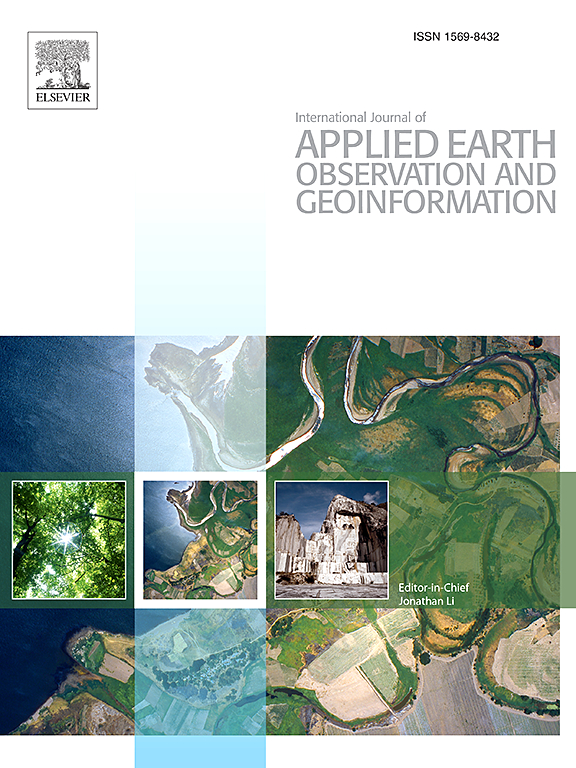Assessing the potential for traffic carbon emission reductions through residential travel mode shifts: insights from massive vehicle trajectory data and scenario simulations
IF 7.6
Q1 REMOTE SENSING
International journal of applied earth observation and geoinformation : ITC journal
Pub Date : 2025-06-20
DOI:10.1016/j.jag.2025.104684
引用次数: 0
Abstract
The choice of transportation mode by residents significantly affects road traffic carbon emissions. Recent studies have explored the carbon reduction effects of green travel behaviors, such as bicycle-sharing and metro travel. However, there remains a gap in research estimating the carbon reduction potential associated with the transition from motorized transport to low-carbon alternatives. In this study, we propose a carbon emission reduction scenario simulation framework based on vehicle trajectory big data. This framework is designed to evaluate the impact of shifts in residential travel modes on carbon emissions at a fine spatial and temporal scale. Our analyses indicate that only 7.2 % of car trips are suitable for a shift to active transportation options, while over 64 % of trips qualify as multimodal, particularly involving e-bikes in combination with metro, which can result in annual carbon reductions of up to 3,138 tons. This highlights the importance of multimodal transport in reducing transportation-related carbon emissions. Regarding the spatial pattern, peripheral areas present substantial carbon reduction potential, accounting for nearly 50 % of the total. Moreover, significant carbon reduction potential exists in road sections connecting central and peripheral areas. In terms of timing, we observe two peaks in emission reductions on weekdays, occurring between 7–9 AM and 4–6 PM, with an additional peak on weekends around 9 PM. Ultimately, our research highlights that multimodal transportation, especially the combination of walking or conventional cycling with metro, may offer greater carbon reduction efficiency than relying solely on active transportation options. The findings of this study can significantly inform urban transportation policy-making and guide residents toward sustainable travel choices.
通过住宅出行模式转变评估交通碳减排的潜力:来自大量车辆轨迹数据和情景模拟的见解
居民交通方式的选择显著影响道路交通碳排放。最近的研究探索了绿色出行行为的碳减排效果,如共享单车和地铁出行。然而,在估计从机动运输向低碳替代方式过渡所带来的碳减排潜力方面的研究仍存在空白。在本研究中,我们提出了基于车辆轨迹大数据的碳减排情景模拟框架。该框架旨在从精细的时空尺度上评估居民出行方式转变对碳排放的影响。我们的分析表明,只有7.2%的汽车出行适合转向主动交通选择,而超过64%的出行符合多式联运的条件,特别是将电动自行车与地铁相结合,这可以导致每年减少高达3138吨的碳排放。这突出了多式联运在减少与运输有关的碳排放方面的重要性。从空间格局上看,周边地区碳减排潜力较大,约占总量的50%。此外,连接中心和外围地区的路段存在显著的碳减排潜力。就时间而言,我们观察到工作日的减排有两个高峰,分别发生在早上7点到9点和下午4点到6点之间,周末在晚上9点左右有一个额外的高峰。最后,我们的研究强调了多式联运,特别是步行或传统自行车与地铁的结合,可能比仅仅依靠主动交通选择提供更大的碳减排效率。研究结果对城市交通政策制定和居民可持续出行选择具有重要指导意义。
本文章由计算机程序翻译,如有差异,请以英文原文为准。
求助全文
约1分钟内获得全文
求助全文
来源期刊

International journal of applied earth observation and geoinformation : ITC journal
Global and Planetary Change, Management, Monitoring, Policy and Law, Earth-Surface Processes, Computers in Earth Sciences
CiteScore
12.00
自引率
0.00%
发文量
0
审稿时长
77 days
期刊介绍:
The International Journal of Applied Earth Observation and Geoinformation publishes original papers that utilize earth observation data for natural resource and environmental inventory and management. These data primarily originate from remote sensing platforms, including satellites and aircraft, supplemented by surface and subsurface measurements. Addressing natural resources such as forests, agricultural land, soils, and water, as well as environmental concerns like biodiversity, land degradation, and hazards, the journal explores conceptual and data-driven approaches. It covers geoinformation themes like capturing, databasing, visualization, interpretation, data quality, and spatial uncertainty.
 求助内容:
求助内容: 应助结果提醒方式:
应助结果提醒方式:


